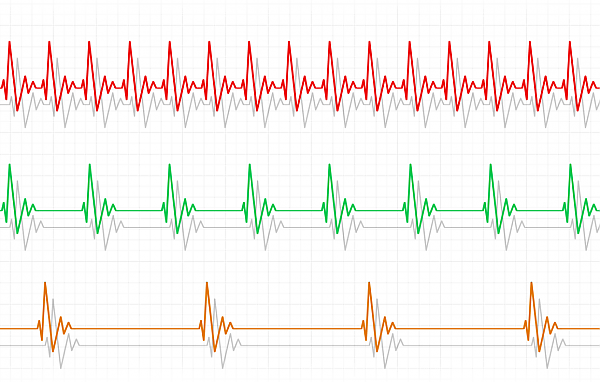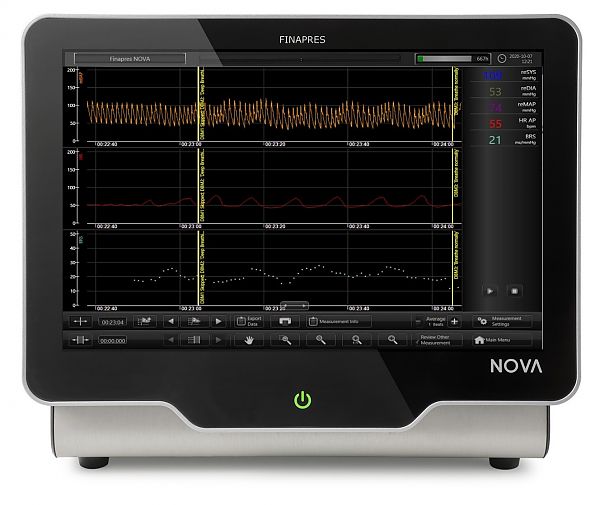Autonomic Testing (AT) software provides Baroreceptor Sensitivity and Heart Rate Variability parameters
The Autonomic Testing (AT) software application enables the Baroreceptor Sensitivity (BRS) and various Heart Rate Variability (HRV) parameters on a Finapres® NOVA Plus with an ECG module. Together, these parameters can aid the physician to obtain detailed insights in the dynamics of sympathetic and parasympathetic innervation of the human cardiovascular system. This supports health care professionals and researchers in studying and diagnosing their patients.
Heart Rate Variability (HRV) parameters
Heart rate variability is the fluctuation in time intervals between adjacent heartbeats. Our HRV parameters are derived from the ECG signal measured with the Finapres® NOVA Plus, obtained in time- and frequency domain, and based on a 5-minutes interval. Subsequently, the HRV signals are updated every heartbeat. A filter is applied to detect and remove abnormal beats. The method to calculate the HRV parameters is based on the HRV Guidelines, published by the European Heart Journal [1].
Baroreceptor sensitivity (xBRS)
The BRS parameter describes the amount of response in heartbeat interval to a change in blood pressure, expressed in ms/mmHg. The BRS parameter is obtained from the systolic blood pressure signal and derived using a well-validated cross-correlation method, which calculates the correlation between beat-to-beat blood pressure and delayed pulse intervals. The measurement of the baroreflex is a source of valuable information in the clinical management of cardiac disease patients, particularly in risk stratification [2]. More details on the calculation and validation are available in this scientific paper from Westerhof et al.[3].
Benefits of Finapres xBRS method compared to other time-sequential methods (such as sBRS) [3, 4]:
- xBRS provides more BRS values per unit of time
- xBRS determinations are more equally distributed over time
- 50% reduction of within-patient variance
- No thresholds for pressure and interval variation needed
Benefits of Finapres xBRS method compared to spectral methods [5]:
- Exact event location in time
- xBRS provides the distribution of BRS per time interval
- No manual editing needed: most artifacts are rejected in the software
As an example of a potential application of the AT software, the image below shows the immediate blood pressure (reBAP), heart rate, BRS response during a deep breathing test recorded with the Finapres® NOVA.
Finapres® NOVA display with reBAP signal (first plot), heart rate (second plot) and BRS signal (third plot).
The Autonomic Testing software is now available for your Finapres® NOVA Plus! It can be upgraded during its lifetime at any time. When this AT software application is combined with our Guided Autonomic Testing (GAT) application, a full PDF report with BRS and HRV parameters is provided after the GAT measurement.
References
- Camm, A. John, et al. "Heart rate variability: standards of measurement, physiological interpretation and clinical use. Task Force of the ESC and the NASPE." (1996): 1043-1065.
- La Rovere, M.T., Pinna, G.D., & Raczak G. "Baroreflex sensitivity: measurement and clinical implications". Annals of noninvasive electrocardiology: the official journal of the International Society for Holter and Noninvasive Electrocardiology, Inc, 13 (2), 191–207.
- Westerhof, Berend E., et al. "Time-domain cross-correlation baroreflex sensitivity: performance on the EUROBAVAR data set." Journal of hypertension (2004): 1371-1380.
- Westerhof, Berend E., et al. "Time course analysis of baroreflex sensitivity during postural stress." American Journal of Physiology-Heart and Circulatory Physiology (2006): H2864-H2874.
- Laude, Dominique, et al. "Comparison of various techniques used to estimate spontaneous baroreflex sensitivity (the EuroBaVar study)." American Journal of Physiology-Regulatory, Integrative and Comparative Physiology (2004): R226-R231.



